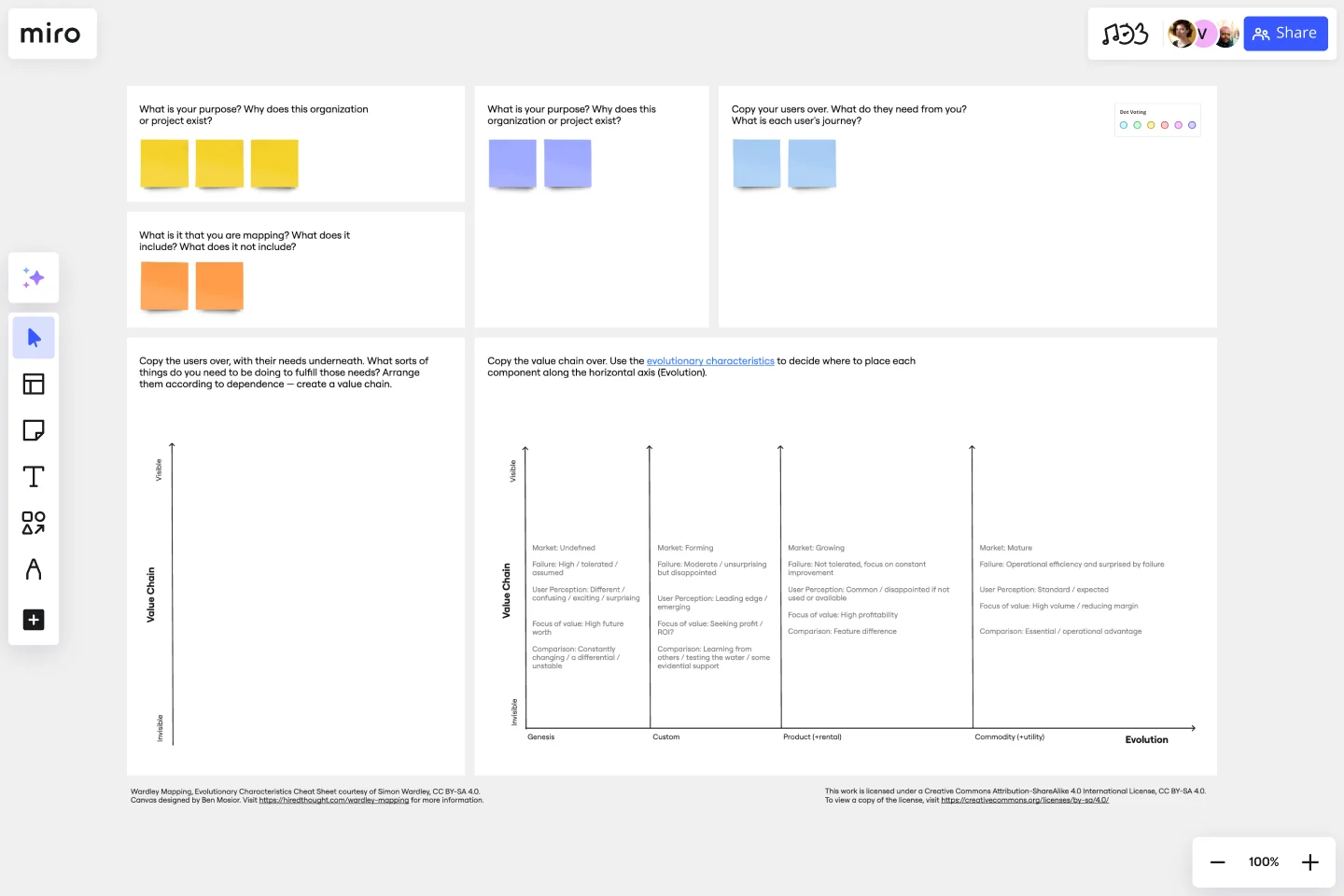Wardley Mapping Canvas Template
Build an intuitive understanding of your business context.
About the Wardley Map template
What is a Wardley Map?
A Wardley Map was developed to map the structure of a business, understand its context, and better serve users. You place components with value on the y-axis and commodity on the x-axis.
Every organization operates within a landscape that contextualizes and influences your decisions. To build a Wardley Map, you must illustrate that landscape as a value chain. What’s a value chain? It’s a series of activities or elements that are required to meet a user’s needs. You categorize each element of the value chain according to their stage of evolution compared to the competition. The resulting Wardley Map describes your assumptions and intentions for anyone to read.
The goal of Wardley mapping is to build a shareable, scalable visualization of the landscape surrounding your business. It allows you to articulate your strategy while summarizing the landscape in a way that’s easy to understand. A Wardley Map is like a time capsule, capturing your understanding at a certain point in time and documenting it for the future.
Why use a Wardley Map?
Use a Wardley map to assess future scenarios, quickly validate solutions, and develop a shared visual understanding of a business' context. Using a Wardley Map, you can significantly reduce a project's risk and avoid costly mistakes.
The benefits of using a Wardley Map
Benefit 1 - Enhance communication. Easily communicate your understanding of the landscape to your team, new hires, and stakeholders. Wardley Maps are powerful tools that can help get new employees up to speed quickly, so they can hit the ground running on day one.
Benefit 2 - Identify risks and opportunities. A Wardley Map clearly lays out the environment in which your product is operating, as well as the value chain that constrains it. This allows you to understand the challenges ahead and how can exploit market gaps.
Benefit 3 - Reduce costs. Wardley Maps help ensure everyone on your team is aligned, and that cross-functional partners share your understanding of the landscape. This alignment reduces costly errors and streamlines your processes.
Benefit 4 - Foster collaboration. Wardley mapping empowers you to minimize risk and conflict across your teams. Teams that engage in Wardley mapping report higher satisfaction, deeper understanding, and closer alignment on shared goals.
Get started with this template right now.
Product Roadmap Canvas Template
Works best for:
Roadmap, Mapping, Planning
The IASA - Product Roadmap Canvas template offers a holistic view of product development by integrating key elements such as customer needs, business goals, and technology requirements. By utilizing this canvas, teams can align their product strategy with market demands and ensure that development efforts are focused on delivering maximum value to customers.
Strategy Map Template
Works best for:
Leadership, Strategic Planning, Mapping
How do your individual or team goals relate to an organization’s overall strategy? A Strategy Map is a stylized picture of your organization’s strategy and objectives. It’s powerful because it provides a clear visual guide to how these various elements work together. Strategy Maps can help align various different team goals with the overall strategy and mission. With the Strategy Map in place, teams can create set actionable, relevant KPIs. Strategy mapping is often considered part of the balanced scorecard (BSC) methodology, which is a strategic planning tool for setting overall team goals.
Product Positioning Template
Works best for:
Marketing, Product Management, Desk Research
For better or for worse, your company’s chances for success hinge partially on your market. As such, before you start building products and planning strategies, it’s a good idea to conduct a product positioning exercise. A product positioning exercise is designed to situate your company and your offering within a market. The product positioning template guides you to consider key topics such as defining your product and market category, identifying your target segment and competitors, and understanding your key benefits and differentiation.
Fishbone Diagram for Service Improvement
Works best for:
Fishbone diagram
The Basic Fishbone Diagram, also known as the Ishikawa or cause-and-effect diagram, is a powerful tool for identifying the root causes of problems. Use this template to systematically explore and document potential causes of an issue, categorizing them into key areas such as people, processes, equipment, and materials. This visual approach helps teams collaborate on problem-solving, ensuring all factors are considered and addressed effectively.
KPI Tree Template
Works best for:
Strategy & Planning
The KPI Tree Diagram is a visual tool that hierarchically illustrates an organization's objectives and breaks them down into their subsequent strategies, tactics, and measurable KPIs. By arranging these components in a tree-like structure, the diagram captures the interrelationships and dependencies between the overarching goals and the specific steps to achieve them.
Venn Diagram Practical Applications
Works best for:
Venn Diagram
The Venn Diagram for Practical Applications template helps you apply Venn diagrams to real-world scenarios. Use this template to solve problems, identify relationships, and make decisions based on clear visual analysis. It's perfect for practical tasks such as project planning, resource allocation, and strategic decision-making. This tool is ideal for business professionals, educators, and anyone looking to apply theoretical concepts to practical situations.
